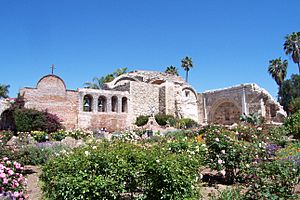Hippolyte Bouchard facts for kids
Quick facts for kids
Hippolyte Bouchard
|
|
|---|---|
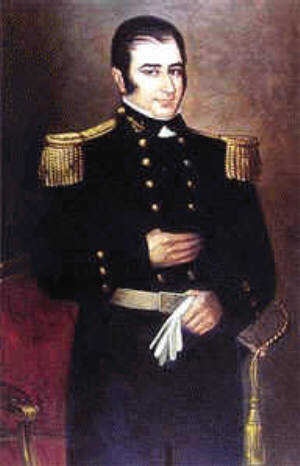
Hippolyte Bouchard, oil on canvas
by José Gil de Castro |
|
| Born |
André Paul Bouchard
15 January 1780, Bormes-les-Mimosas, France
|
| Died | 4 January 1837 (aged 56) |
| Parent(s) |
|
Hippolyte or Hipólito Bouchard (born January 15, 1780 – died January 4, 1837) was a brave French-born Argentine sailor and privateer. He fought for the independence of Argentina and Peru.
During his first adventure as an Argentine privateer, he attacked ships in the Spanish colonies of Peru and Ecuador. He sailed under the command of the Irish-Argentine Admiral William Brown. On his long journey across the seas, he blocked the port of Manila. In Hawaii, he rescued an Argentine privateer ship that had been taken over by rebellious sailors. He also met the local ruler, King Kamehameha I.
Bouchard's forces even took over Monterey, California, which was a Spanish colony at the time. They raised the Argentine flag and held the town for six days. After leaving Monterey, he raided Mission San Juan Capistrano in Southern California. Towards the end of his voyage, Bouchard attacked Spanish ports in Central America. Today, Argentina remembers him as a hero and a patriot, and many places are named in his honor.
Contents
Early Life and Joining the Fight
Bouchard was born in 1780 in a small village near Saint-Tropez, called Bormes-les-Mimosas. He was named André Paul but later went by Hippolyte. He first worked on French merchant ships and then joined the French Navy. He fought in campaigns against the English, which began his life at sea.
After fighting in Egypt and the Saint-Domingue expedition, Bouchard moved to Argentina in 1809. He wanted to help the May Revolution and joined the National Argentine Fleet. On March 2, 1811, he fought for the first time under the Argentine Flag. He helped defend Buenos Aires from a Spanish blockade in July and August of that year.
In March 1812, Bouchard joined the Mounted Grenadiers Regiment led by José de San Martín. He took part in the Battle of San Lorenzo in 1813, where he bravely captured a Spanish flag. Because of this, he was given Argentine citizenship. A few months later, he married Norberta Merlo.
Adventures with William Brown
In 1815, Bouchard began a naval journey with Admiral William Brown. They attacked the fortress of El Callao and the city of Guayaquil in Ecuador. On September 12, 1815, Bouchard received a special license to fight the Spanish as a privateer. He commanded a French-built ship called the Halcón.
The fleet included Brown's ship Hercules, his brother's ship Santísima Trinidad, the Constitución, and Bouchard's Halcón. They planned to meet at Mocha Island. Bouchard's ship faced bad weather, and the Constitución was lost at sea. Brown and Bouchard agreed to work together for the first few months of 1816.
On January 10, 1816, the three ships met near the fortress of El Callao. They blocked the port and fired cannons at Guayaquil. They captured several Spanish ships, including the San Pablo and the Gobernadora. On January 21, they attacked the fortress again, sinking the ship Fuente Hermosa.
Later, William Brown tried to attack the castle of San Carlos but was captured by Spanish forces. After talks, the Argentines traded Brown for one of their captured ships, the Candelaria, and some other items.
After this, Bouchard's ship was in bad shape, and his officers wanted to return to Buenos Aires. He received some captured ships and money as his share. Bouchard sailed back to Buenos Aires, facing more challenges with his crew. He arrived in Buenos Aires on June 18.
The La Argentina Campaign
Starting a New Journey
Bouchard decided to use the captured ship Consecuencia for his next big adventure. He renamed it La Argentina. Getting the ship ready was tough because it was very large. They added 34 cannons and hired skilled carpenters. The Argentine government gave him more cannons and supplies.
Finding 180 sailors for the crew was even harder, as Bouchard had a reputation for being strict. Most of his crew were foreigners, with some from Argentine provinces. On June 25, a fight broke out among the crew, leading to some injuries and deaths. This showed the challenges of leading such a diverse group.
On June 27, Bouchard received his official "letter of marque" from Argentina. This allowed him to attack Spanish ships, as Spain and Argentina were at war.
On July 9, 1817, La Argentina set sail from Ensenada de Barragán for a two-year journey. Bouchard planned to sail around the Cape of Good Hope to attack Spanish trading ships. However, a fire broke out on board on July 19, which the crew fought for hours.
Because of the fire, the ship had to stop in Madagascar for two months for repairs. While there, Bouchard helped a British officer stop some slave ships. Many of his crew then got scurvy, a serious illness. On October 18, he learned that the Spanish trading company he planned to attack had stopped its operations years ago.
Facing Pirates in the Philippines
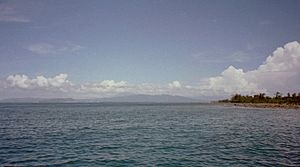
La Argentina then headed towards the Philippines, sailing through storms in the Sunda Strait. On November 7, Bouchard landed in Java to let his sick crew recover. The journey to the Philippines was dangerous because of Malayan pirates.
On December 7, four pirate ships were spotted. The largest pirate ship tried to attack La Argentina. Bouchard's crew fought bravely and captured the pirate ship. Bouchard decided to punish the pirates severely, sinking their ship with most of them still on board. Only the youngest pirate was spared.
Visiting the Sulu Islands
After sailing through the Makassar Strait, La Argentina reached the island of Joló on January 2, 1818. They stayed for five days. The waters were tricky with many rocks and strong currents. The people of Joló were known for their bravery and their economy was based on piracy.
While the crew traded for supplies, guards were on watch. One night, they saw boats approaching dangerously. The crew prepared their weapons and fired, surprising the Joloans, who quickly fled. Later, the local ruler arrived with gifts of food and buffaloes. After this, the crew could get supplies peacefully.
Blockading Manila

Bouchard then sailed to the Spanish port of Manila to block it. When he arrived on January 31, 1818, he stopped an English ship to check for supplies for the Spanish colony. The English captain warned the Spanish authorities about Bouchard's plans. Manila was a strong city with fortified walls and a powerful fort called Fort Santiago.
Bouchard began to capture nearby ships, staying away from the Spanish cannons. Over two months, La Argentina captured 16 ships. This caused food prices in Manila to double or even triple. The governor sent ships to fight La Argentina, but Bouchard had already left the area on March 30.
A few days later, Bouchard's men tried to capture a Spanish ship near Santa Cruz but faced strong resistance. Fourteen of Bouchard's men were killed. To get revenge, Bouchard used a smaller ship to attack again, but the Spanish crew had fled. He continued sailing and captured a ship carrying royal funds.
La Argentina then sailed to the Sandwich Islands (now Hawaii) to find new crew members, as many had died from scurvy. Bouchard hired Peter Corney to captain a captured ship called the Santa Rosa. This ship had a diverse crew, including Filipinos who had joined the fight against Spain.
In Hawaii
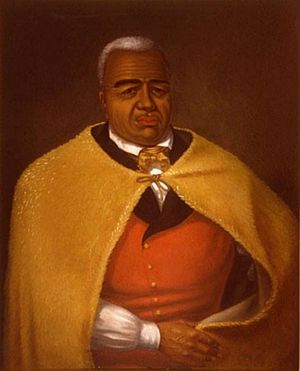
On August 17, Bouchard arrived at Kealakekua Bay in Hawaii. He learned that another ship, the Santa Rosa, was in the harbor. This ship had been sold to King Kamehameha I after its crew had mutinied near Chile.
Bouchard met with King Kamehameha I, wearing his uniform. He demanded that the Santa Rosa be returned. The king said he had paid for the ship and wanted payment. Bouchard traded his sword and hat, and was given an honorary title. Some historians believe this was the first "international treaty" signed by Argentina with a non-Latin American country.
After getting supplies in Maui and Oahu, Bouchard took control of the Santa Rosa. He sailed to Kauai island, where he found the mutineers. He punished them and then bought food and ammunition. With eighty new men, the fleet left Hawaii and headed for California.
Attacks in California and Central America
Bouchard sailed to California to attack Spanish trade. However, the Spanish authorities already knew he was coming. The governor of Monterey, Pablo Vicente de Solá, ordered valuables and gunpowder to be moved away from the city.
On November 20, 1818, Bouchard's two ships were spotted near Monterey. The Spanish prepared their defenses, and women and children were sent to a mission inland. Bouchard planned his attack. They used the smaller Santa Rosa to attack first, as La Argentina was too big for the shallow waters.
The Santa Rosa anchored too close to the Spanish cannons and was forced to surrender after a short fight. Bouchard saw his men defeated but also noticed the Spanish couldn't capture the Santa Rosa. He rescued the survivors.
On November 24, before dawn, Bouchard led 200 men ashore. They landed a few miles from the fort. After an hour of fighting, the Argentine flag flew over the fort. The Argentines held the city for six days, taking cattle and burning the fort and Spanish houses. The town's people were not harmed.
On November 29, they left Monterey and sailed to Refugio Canyon, near Santa Barbara. They raided the Ortega family's ranch, taking food and killing cattle. Spanish cavalry captured three of Bouchard's men. Bouchard burned the ranch and went to Mission Santa Barbara to get his men back. After talks, the three captured men were returned, and Bouchard freed one Spanish prisoner.
On December 16, the ships sailed to Mission San Juan Capistrano. Bouchard demanded food and ammunition. A Spanish officer refused, so Bouchard sent 100 men to take the town. After a short fight, the privateers took valuables and burned Spanish houses. On December 20, they left to repair their ships.
Bouchard became known as "California's only pirate" by the Spanish. To avoid his attacks, other missions moved their valuables inland.
On January 17, they sailed to San Blas in Mexico and started a blockade. They captured a Spanish ship carrying cacao. They also stopped a British ship and took its Spanish goods. On March 1, they chased a schooner but couldn't catch it. Bouchard then sailed south to Acapulco, but found no important ships there.
On March 18, the Argentines went to Sonsonete in El Salvador. They captured a ship there. On April 2, they arrived at El Realejo. Bouchard led 60 men in boats to attack. The Spanish had four ships defending the port. After a tough fight, Bouchard captured three ships. He burned two of them because their owners didn't offer enough money. He kept the other two, the Neptuno and the María Sofía.
After this battle, they met a Chilean ship that had once been Spanish. This ship attacked the Santa Rosa, which had inexperienced sailors. Three Argentines were killed. The Chilean ship, named Chileno, was also a privateer. Bouchard asked their surgeon to help his wounded, but the Chilean ship sailed away.
On April 3, 1819, Hippolyte Bouchard's long journey ended. He sailed to Valparaíso, in Chile, to help José de San Martín free Peru. Some historians believe that the flags of Central American countries were inspired by the Argentine Flag that Bouchard carried.
Arrest in Chile
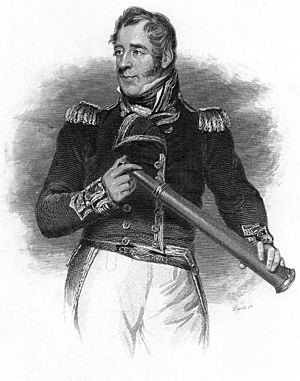
On July 9, 1819, Bouchard's ships arrived in Valparaíso. He was told that Thomas Cochrane had ordered his arrest. Bouchard argued that the Chilean government had no right to judge him.
His trial for piracy began on July 20. To support Bouchard, Argentine Colonel Mariano Necochea and his men took control of La Argentina. This helped speed up the trial. On December 9, the judge decided to return all of Bouchard's ships, papers, and documents. However, his money and captured goods were not given back.
His ships had no sails or cannons because they had been taken by the Chilean navy. Bouchard was almost broke. He used one ship to carry clay to Buenos Aires. He even changed the name of La Argentina back to Consecuencia. His ships were then used to transport soldiers, cattle, and weapons.
Later Life and Legacy
In 1820, Bouchard served with the Chilean navy in Peru. In December, he asked José de San Martín, who was the Protector of Peru, if he could return to Argentina because he was having money problems. San Martín asked him to stay in Lima for four more months.
When Lord Cochrane took money from warships for unpaid wages, San Martín decided to act. He created the Peruvian Navy, and Bouchard was given command of a captured ship called the Prueba. Bouchard even challenged Cochrane to a duel at sea, but Cochrane refused and sailed back to Valparaíso.
After this, Bouchard continued sailing in Peruvian waters. His ship Consecuencia had to be sold for firewood. The Santa Rosa was later burned during a rebellion in El Callao in 1824. Bouchard also fought in a war against Gran Colombia in 1828. After Admiral Martín Jorge Guise died, Bouchard was in charge of the Peruvian Navy for a year before retiring.
During his retirement, Bouchard lived on properties given to him by the Peruvian Government near Palpa. He started a sugar mill. He had lost touch with his family years before. He died on January 4, 1837.
In Argentina, Bouchard is honored as a patriot. Many places, including a street in downtown Buenos Aires, are named after him. A US Navy destroyer, USS Borie, was sold to Argentina in 1972 and renamed ARA Hipólito Bouchard. This ship even saw action in the Falklands War.
Images for kids
See also
 In Spanish: Hipólito Bouchard para niños
In Spanish: Hipólito Bouchard para niños




